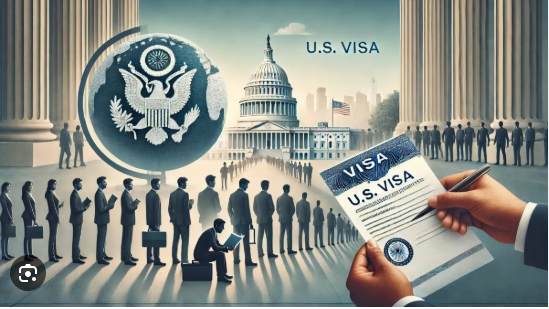The U.S. travel and immigration landscape is set to undergo significant transformations in 2025, with reforms aimed at modernizing processes, enhancing security, and adapting to post-pandemic global trends. Whether you’re a tourist, student, professional, or entrepreneur, these changes could reshape how you plan your journey to the United States. In this comprehensive guide, we break down the latest updates, their implications, and actionable steps to navigate the new system.

1. Introduction: Why 2025 Marks a Turning Point
The U.S. Department of State and Homeland Security have announced sweeping updates to visa policies, reflecting evolving priorities such as digital innovation, reciprocity agreements, and national security. These changes come amid rising global mobility demands and lessons learned from pandemic-era backlogs. From streamlined digital applications to new visa categories, 2025 promises to redefine access to the U.S. for millions of travelers.
2. Overview of Key 2025 Visa Changes
The 2025 reforms focus on five pillars:
- Digitization of Visa Processes (e.g., virtual interviews, online submissions).
- Introduction of New Visa Categories (e.g., remote work visas).
- Revised Fee Structures (cost increases for certain visas).
- Enhanced Security Protocols (biometric data, AI-driven screenings).
- Reciprocity Adjustments (extended validity for select countries).
Let’s dive into each.
3. Key Changes and Their Implications
a. Digital Visa Application Processes
What’s New?
- Virtual Interviews Expanded: The pilot program allowing online visa interviews for renewals (launched in 2021) will become permanent for most non-immigrant visas (B1/B2, F1, H1-B). First-time applicants from Visa Waiver Program (VWP) countries may also qualify.
- AI-Powered Processing: USCIS will deploy artificial intelligence to review applications, reducing processing times by up to 30%.
- ESTA Modernization: Travelers from VWP countries (e.g., UK, France) must now submit additional digital documentation, including proof of financial stability and travel insurance, via the Electronic System for Travel Authorization (ESTA).
Impact: Faster processing for low-risk applicants but stricter initial screenings. Applicants from high-risk regions may face delays due to enhanced AI scrutiny.
b. New Visa Categories
What’s New?
- Digital Nomad Visa (DNV): A 24-month visa for remote workers employed by non-U.S. companies. Requires proof of income (~$5,000/month) and health insurance.
- Startup Visa: Targeting entrepreneurs, this visa replaces the International Entrepreneur Rule (IER), offering a 3-year stay for founders securing $250,000+ in U.S. funding.
- Climate Talent Visa: A proposed category for professionals in renewable energy and climate tech (details pending Congressional approval).
Impact: Opportunities for remote workers and innovators, but eligibility criteria remain stringent.
c. Revised Fee Structures
What’s New?
- Tourist/Business Visas (B1/B2): Fees increase from 160to160to240.
- Student Visas (F1/M1): Application costs rise by 15%, with a new $100 “Academic Security Surcharge” for STEM fields.
- Premium Processing: Expanded to H-2A (agricultural) and O-1 (extraordinary ability) visas, costing 2,500(upfrom2,500(upfrom1,440).
Impact: Higher costs may deter short-term visitors but expedite premium services for professionals.
d. Enhanced Security and Background Checks
What’s New?
- Biometric Requirements: Facial recognition and fingerprinting mandatory at all U.S. ports of entry.
- Social Media Vetting: Applicants must provide 5-year social media histories (previously 2 years).
- Anti-Discrimination Algorithms: AI tools will flag inconsistent application answers to reduce fraud.
Impact: Increased privacy concerns but reduced fraud rates. Prepare for longer pre-interview preparation.
e. Visa Validity and Reciprocity Adjustments
What’s New?
- 10-Year Tourist Visas for India: Reflecting reciprocity agreements, Indian nationals gain access to 10-year B1/B2 visas (up from 5 years).
- Reduced Validity for Overstayers: Countries with >5% overstay rates (e.g., Nigeria, Venezuela) may see shortened visa terms.
Impact: Favorable terms for compliant travelers but stricter penalties for violations.
f. Sector-Specific Updates
- Students (F1): OPT extensions for STEM graduates extended to 36 months (from 24), but tied to employment in “critical sectors” like AI and quantum computing.
- H-1B Workers: Lottery system replaced with a salary-tiered selection process, prioritizing higher wages.
- Tourists (B2): Proof of return travel and accommodation required upfront.
4. How to Prepare for the 2025 Changes
- Start Early: Begin applications 6+ months in advance, especially for visas requiring interviews.
- Budget for Fees: Account for higher costs; explore fee waivers if eligible.
- Organize Digital Records: Digitize financial statements, employment letters, and social media histories.
- Monitor ESTA Updates: VWP travelers should renew ESTA authorizations early to avoid 2025 system glitches.
5. Conclusion: Adapting to a New Era of U.S. Travel
The 2025 visa reforms aim to balance openness with security, offering opportunities for skilled professionals while tightening controls on high-risk travelers. Staying informed through official channels (USCIS.gov, Travel.State.gov) and consulting immigration attorneys will be key to navigating this evolving landscape.
As the U.S. positions itself to attract global talent and streamline entry, these changes underscore the importance of preparation and adaptability. Whether you’re planning a vacation, degree, or career move, understanding these updates ensures you stay ahead in the new era of U.S. travel.

